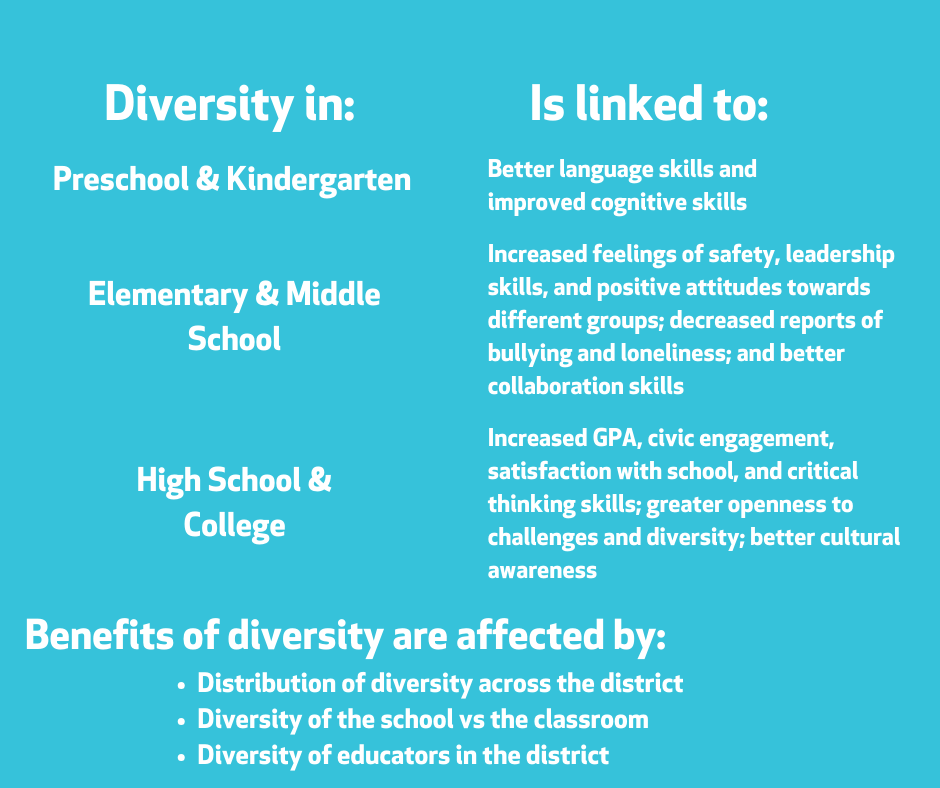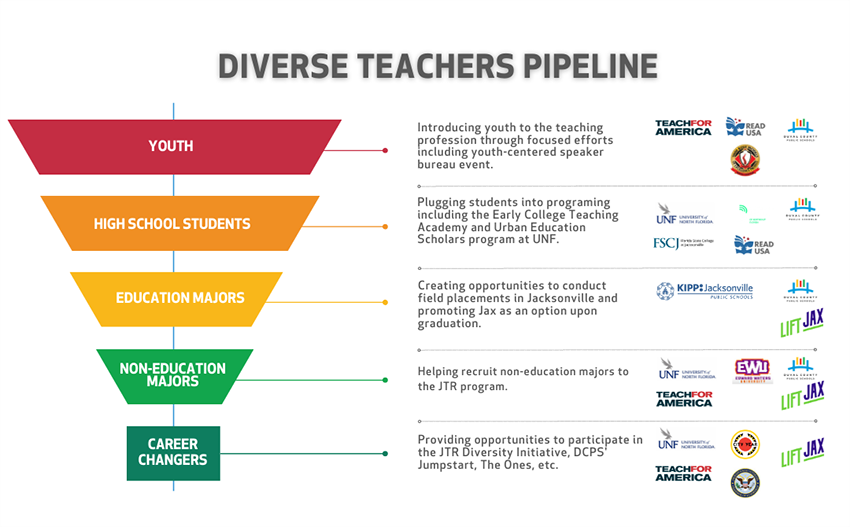Why equity is for everyone
Diversity benefits all students
11/17/2023

Duval County has been and continues to increasingly be home to a diverse, multicultural student population from many backgrounds. In the 2023-2024 academic school year, over half of the students in Duval County Public Schools (DCPS) are reported to be from historically marginalized racial and economic backgrounds.
Additionally, there are 103 languages spoken in DCPS schools including Spanish, Arabic, Portuguese, Burmese, Vietnamese, Tagalog, Russian, Creole, Albanian, Haitian-Creole, Swahili, Farsi, Persian, Turkish, French, Bosnian, Karen, and more! This is great for Duval County as research suggests there are benefits of diversity for all students at all levels of education. However, more can be done to improve aspects that affect whether students see benefits, such as the diversity of educators in the district.
Preschool & Kindergarten - Better Language Skills
-
Studies have found that students from low-income backgrounds who attend economically and racially diverse preschools show greater gains in language and cognitive skills than students from low-income backgrounds who attended schools that were not as diverse. Additionally, students from low-income backgrounds in that study who spoke English at home showed similar gains to their peers from high-income backgrounds.
-
One study that included data from nearly 3,000 students across 704 classrooms found that all preschoolers gained better language skills in more racially and ethnically diverse classrooms, regardless of their own race/ethnicity and family income.
Given how closely language skills are tied to developing early literacy, which is foundational to education and life success, it is important to know what can foster those skills. Aside from the wealth of diverse languages spoken in the district, DCPS is home to several dual-language programs for kindergarten age students to encourage strong language skills from an early age.
Elementary & Middle School - Increased collaboration skills and safety
-
Studies of elementary aged students have found that, regardless of ethnic background, all students report feeling safer at school, less bullied, less alone, and more positive towards different groups, and have some higher academic outcomes in more ethnically and racially diverse school settings.
-
Research has also found in longitudinal studies of over 6,000 middle school students that diverse peer groups are associated with better leadership and collaboration skills, as well as improved feelings of safety.
Feelings of safety and ability to collaborate are essential for learning and successfully navigating school and life. Diverse schools offer spaces where students can dispel misinformation about different groups and learn better collaboration. Affinity groups for marginalized groups (e.g., race, sexuality) offer similar benefits for all students who attend, regardless of school level diversity.
High School & College- Increased critical thinking skills and civic engagement
-
Studies have found that college students who come from more diverse high schools were significantly more likely to have a higher Freshman GPA than students who came from less diverse high schools, even after controlling for other factors like high school rank, ACT scores, and school quality.
-
Ample research has documented the link between attending diverse school settings and positive impacts on students critical thinking skills, civic engagement, cultural awareness, satisfaction with school, and openness to diversity and challenges.
Business leaders across the country and in Duval County assert that critical thinking, problem solving, and openness to challenges are key skills they are looking for in today's workforce. Beyond each individual students’ success, when students fully experience the cognitive, social, psychosocial, and academic benefits of diversity across the life span, they are more likely to spend time contributing back to and improving their community through innovative and creative problem solving.
What affects whether or not students benefit from diversity?
Diversity of the student population on its own is not enough to see all the benefits discussed in this blog. Other factors that allow students to fully benefit from a diverse student population include the diversity of school staff and curriculum and the distribution of student diversity across the district and in schools versus classrooms.
While the district as a whole is home to a diverse population of students, the distribution of that diversity across the different schools and classrooms is important to understand how much diversity students are actually experiencing.
The benefits of diversity have been found to be limited in districts where historically marginalized students are clustered in a few schools and in schools where historically marginalized students are underrepresented in gifted or advanced courses, because the students are not experiencing authentic diversity in their daily classroom experience.
The presence of diverse educators has also been linked to positive academic and psychological outcomes for all students, but especially for historically marginalized students. For example, Black educators have been found to be more likely to recommend Black students to gifted programs and have higher expectations of Black and Brown students than other teachers.
In Duval County, only about a third of educators report historically marginalized racial backgrounds, suggesting there is room for improvement in one of the foundational pillars for students experiencing benefits of diversity.
"Investing resources into recruiting, preparing, and retaining educators from diverse backgrounds is key to supporting all student success and fully leveraging the benefits of a diverse student population."
The Jacksonville Public Education Fund, Duval County Public Schools, the University of North Florida and many community partners are two years into the 1000By2025 Initiative, which focuses on the recruitment and retention of high quality Black and Latino male educators to Duval County Public Schools. For more information, visit TeachDuval.com. Additionally, attending school board meetings and advocating for policies that support the equitable access of resources across the district is essential for supporting students in all schools.
References
-
Benner, A. D., & Crosnoe, R. (2011). The racial/ethnic composition of elementary schools and young children’s academic and socioemotional functioning. American Educational Research Journal, 48(3), 621-646
-
Bowman, N. (2010). College diversity experiences and cognitive development: A metaanalysis. Review of Educational Research, 80(1), 433.
-
Duval County Public Schools. (2023). Enrollment Data. https://dcps.duvalschools.org/cms/lib/FL01903657/Centricity/Domain/8889/EXD_PDF/EXD_School_D016.pdf
-
Graham, S. (2018). Race/ethnicity and social adjustment of adolescents: How (not if) school diversity matters. Educational Psychologist, 53(2), 64-77
-
Graham, S., Munniksma, A., & Juvonen, J. (2014). Psychosocial benefits of cross‐ethnic friendships in urban middle schools. Child development, 85(2), 469-483.
-
Gershenson, S., Hart, C. M., Hyman, J., Lindsay, C., & Papageorge, N. W. (2018). The long-run impacts of same race teachers (No. w25254). National Bureau of Economic Research.
-
Gist, C. D., & Bristol, T. J. (Eds.). (2022). Handbook of research on Teachers of Color and Indigenous Teachers. American Educational Research Association.
-
Grissom, J. A., & Redding, C. (2015). Discretion and disproportionality: Explaining the underrepresentation of high-achieving students of color in gifted programs. AERA Open, 2(1), 2332858415622175.
-
Juvonen, J., Kogachi, K., & Graham, S. (2018). When and how do students benefit from ethnic diversity in middle school?. Child development, 89(4), 1268-1282
-
Reid, J. L., & Kagan, S. L. (2015). A Better Start: Why Classroom Diversity Matters in Early Education. Poverty & Race Research Action Council.
-
Reid, J. L., & Ready, D. D. (2013). High-quality preschool: The socioeconomic composition of preschool classrooms and children's learning. Early Education & Development, 24(8), 1082-1111.
-
Schechter, C., & Bye, B. (2007). Preliminary evidence for the impact of mixed-income preschools on low-income children's language growth. Early Childhood Research Quarterly, 22(1), 137-146.
-
Tam, M. Y. S., & Bassett Jr, G. W. (2004). Does diversity matter? Measuring the impact of high school diversity on freshman GPA. Policy Studies Journal, 32(1), 129-143.
-
Williams, S. M., & Graham, J. (2019). Cross-racial interactions in schools 65 years after Brown. Peabody Journal of Education, 94(5), 545-554.